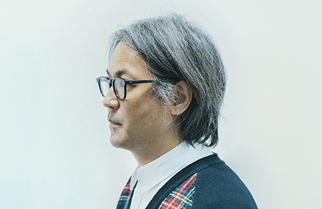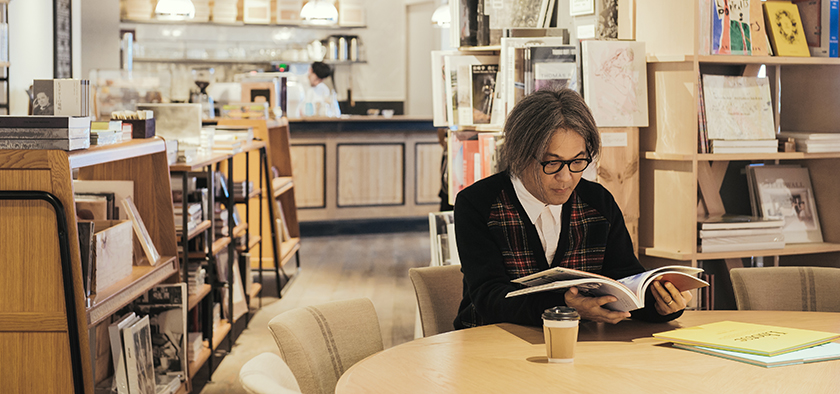
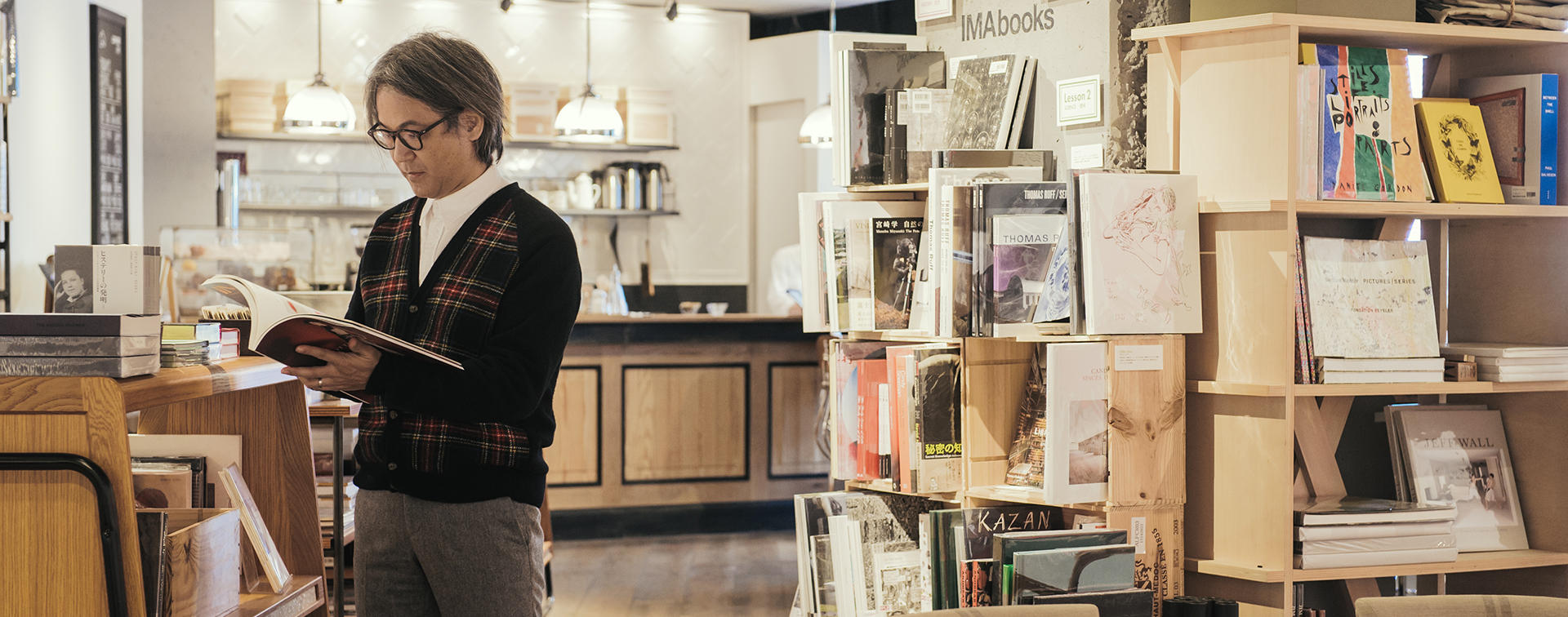
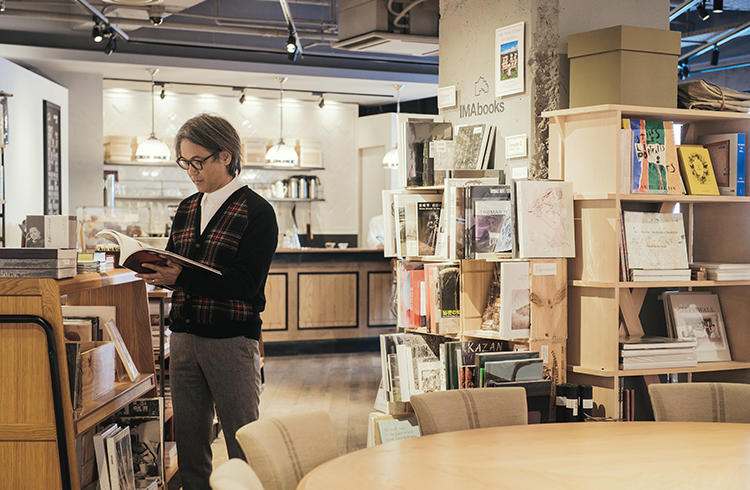
Roppongi “villages” and the Japanese sense of harmony
A camp event for socializing around fire
Spatial designer Junji Tanigawa has worked in a wide range of genres including events, exhibitions and installations based on the concept that space is a medium through which messages can be delivered. The main photographs for this interview article were taken at the IMA STORE whose space Tanigawa designed. Others spaces in Roppongi desgined by Tanigawa include the GOOD DESIGN EXHIBITION and MEDIA AMBITION TOKYO. We asked him what kind of things he would like to do in the future.
Encountering kindred spirits in Roppongi
I used to come to Roppongi for fun when I was a student; in those days, it wasn't a place for design or art, but a night town for adults. Then the years passed, and Roppongi Hills Tokyo Midtown, and the National Art Center, Tokyo, were built, and Roppongi began to have many "faces". It previously had only a nighttime face but it was also given a daytime face. That was probably the turning point for Roppongi,; the area began to have the current Tokyo-like atmosphere. There seems to be more places now where you can encounter interesting things happening.
It seems to me that a lot of new communities with all kinds of characters have sprung up in Roppongi. They're like villages. We have the village of Roppongi Hills, the village of Tokyo Midtown and the village of the National Art Center, Tokyo. They're not actual spaces, but communities of kindred spirits - people getting together in certain places because the culture and traits of the place resonate with them. Strangers might meet and find a common interest to talk about, and they might marvel at what a small world they live in. They are villagers, you see. I'm sure many people have the experience of meeting someone for the first time and striking up a conversation.
Since the Edo period, Tokyo has periodically gone through a process of "scrap and build" (demolishing old buildings and building new ones). The memory of "scrap and build" seems to be in our DNA, and we hardly feel any unease at seeing the landscape of a town change. When a new building is built, we often completely forget about what was there before.
Roppongi is a place where "scrap and build" is particularly frequent. I would liken it to music sampling where different types of music are layered and made into something new. Tokyo is a city where all kinds of things have been built on top of one another, layer after layer, and Ropppongi is an area which has the most mixed-up blend of culture.
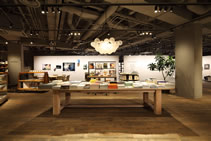
IMA CONCEPT STORE
A bookstore with an art gallery and cafe that opened March 2014 on the third floor of the AXIS building. The multi-purpose space is intended to let people enjoy photographs in many different ways. Junji Tanigawa was in charge of spatial design, while the architectural design was undertaken by SANDWICH, a group led by Kohei Nawa.
photo: Kozo Takayama
A place where passersby can look at designs
Roppongi is a place that transmits a lot of information, especially concerning design and art. I've been involved with the GOOD DESIGN EXHIBITION for about eight years; the venue for this exhibition was moved from Tokyo Big Sight to Tokyo Midtown in 2013. The facilities at Tokyo Big Sight were better in some ways since they were more spacious and it was easier to transport things. However, we felt that Tokyo Midtown was the appropriate venue. Designs are not really things that you have to make an effort to go and see. Designs exist everywhere in our daily lives. We wanted people to realize that, and we thought it was more natural to put our exhibition in a place where it would be seen by ordinary people who hadn't come with the express purpose to see it.
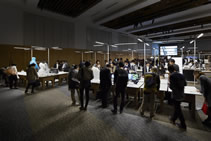
GOOD DESIGN EXHIBISION
An exhibition for showing all the prize-winning works of the Good Design Award. Junji Tanigawa has been spatial designer for the exhibition's venues since 2007. Since 2013, the prize-winning works have been shown in several places within Tokyo Midtown. About 1,300 works were put on display in 2014.
©Forward Stroke inc.
The Good Design Award is a design award with the longest history in Japan. It is an award that is meant to continue long into the future and I hope it will flourish. For it to flourish, it's important to have format and form. One way of holding events is to change the date and location every year, but that way, people who aren't interested in the event will forget about it. I think it's better to always hold an event in the same place so that the experience of the event becomes rooted to the ground. That way, the quality of the event becomes better and communication between people can expand. It should be like a festival at a jinja (Shinto shrine) with the memories of the past unchangingly carried on.
The old and the new in Japan
In Japan, importance is placed on the inheritance of traditional culture, but not everything that is old is necessarily preserved. There are cases when things are renewed and what was tangible disappears, yet the intangible assets are inherited. One example is the Shikinen Sengu ceremony of the Ise Jingu (Ise Grand Shrine). Once every 20 years, the deity is moved to a temporary shrine and all the buildings close to the deity are renovated. There is format and form in this. The ceremony is not just about physically renewing something because it has become old; it's also about inheriting the memories. There's a spiritual aspect to the repeated process of "scrap and build". The intriguing and wonderful thing about Japan is that in all parts of its culture there is a blend of the unchanging elements with the innovative elements.
I think this blending is part of the philosophy of "wa" (harmony). According to the dictionary, "wa" means being anchored in oneself, and at the same time, accepting others. The Japanese have absorbed all kinds of things from other cultures, and have given their own style to them, turning them into a form of art. When imbued with the Japanese spirit, the act of simply arranging flowers becomes "kado" (way of flowers), while the act of drinking tea becomes a "sado" (way of tea). Something that is mundane in other countries gains artistic value here. It seems to me that the same thing can be said of Japanese customs and hospitality.
Returning to the topic of Roppongi, I think "wa" can be seen in Roppongi Art Night where art is incorporated into an area known for its nightlife. It's an event where young art freaks walk around the neon-lit streets chatting and laughing. It would be very difficult to hold a similar event in other cities because of safety concerns. I think people abroad will be surprised to see what Japan has come so far. It's an innovative event although we take it for granted now.

How MEDIA AMBITION TOKYO was born
Milan has the Milano Salone (Salone del Mobile) and Paris has the Paris Fashion Week; leading cities have representative events. I wondered to myself whether Tokyo has an event that draws people from around the world - an event which makes people look at the calendar and schedule their visit a year in advance. I came to the conclusion that even though there are many events going on every day and even though there is potential in some genres, Tokyo has not been able to create an event that draws visitors and transmits information on the scale of Milano Salone or Paris Fashion Week.
Paris has fashion and Milan has interior items, so what theme should Tokyo have to lure people? I started thinking about this while working for the Japan Media Arts Festival, and I came up with the idea of offering visitors an experience of Japan through art and technology. I realized that we should expand the possibilities in the areas of technology art, games, animation and manga - areas where Japan has taken the world by storm. That's why we started the event MEDIA AMBITION TOKYO in 2013 with Roppongi as the main venue.
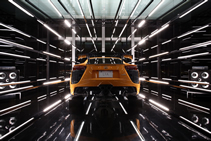
MEDIA AMBITION TOKYO
A technology art event showing the latest works in innovative art, images, music and performance art. The main venue in 2014 was the 52nd floor of Roppongi Hills and drew approximately 110,000 visitors. Works by 16 artists including WOW, rhizomatiks, and teamLab were exhibited for roughly two months. The event is scheduled Feb.11 (Wed) - Feb. 15(Sun) 2015, marking its third year.
Photo by Ken Ishii/Getty Images for Media Ambition Tokyo
In February each year, many Japanese and overseas artists come to Tokyo for the Japan Media Arts Festival. In the past, all these artists were gathered here during the period of the festival but it was only their works that were exhibited; for various reasons we weren't able to ask the artists to do things like give performances. I thought that was really a pity. I wanted to ask the artists to perform and I thought maybe we could create something of larger value if we established a platform for everyone to directly communicate with each other. It all started from that simple idea.
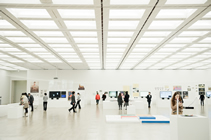
Japan Media Arts Festival
An annual media arts festival held by Japan's Agency for Cultural Affairs. A call is made for works from around the world in the four divisions of Art, Entertainment, Animation and Manga. Prize-winning works are given a wide platform for appreciation. Since 2007, the event has been held at National Art Center, Tokyo. In 2014, which was the event's 17th year, a total of 4,347 entries were made from 84 countries and regions. Next year, the festival is scheduled to take place Feb. 4 (Wed) - 15(Sun.)
February was the ideal month to hold the event. In the other months, there is a series of big events; the Milan fashion week and Paris fashion Week are held in March, and the Milano Salone is held in April. But in February, there are no other international events to compete with. It's a month when the media or the so-called "creative press" which provide information on such events do not have a busy schedule. So we decided to focus on that time of year.
An event to showcase new forms of expression
MEDIA AMBITION TOKYO is "an exhibition of Tokyo and the world, past and future, technology and art" and we call it MAT. It's still a fledgling event, having being held only for the second time in March 2014. To prepare for the event, we work day and night, putting all our energy into planning things. Let me explain about the format for MAT.
The fact is, in Tokyo alone, numerous events related to art and technology used to be held in February. By putting all these events together on the same MAT platform, more information has become accessible to the visitors. There are navigation tours for the event, and we prepare promotion materials to create buzz. In the evenings, we have receptions and small gatherings for people to exchange information so that corporations can discover new talent and artists can be given fresh opportunities.
In this age of social media, information is disseminated at a speed that was unthinkable in the past; by the second day of an event, people start announcing that they found it interesting, and by the third day, they are telling others which specific spots they should visit. So it's important for us to provide hospitality to the people giving out information. We welcome anything that can be provided for this event whether it's space, or things or wisdom. A showcase of technology art in the city - that is what we want MAT to become.
Roppongi is an area that does not sleep, and it's convenient that we can make presentations both during the day and night. It's also good that Roppongi as a whole is like a laboratory, with an experimental atmosphere. I hope that in the future, Tokyo as a whole will become mediatized, and the newest forms of media expression that captures the imagination of everyone will be displayed everywhere in the city. Then people from all over the world will want to visit this "most innovative place in Japan" since the wonder of it cannot be experienced unless you are physically here. If MEDIA AMBITION TOKYO could offer such an exciting experience for several days, then I'm sure more people from abroad will mark this event on their calendars.
A vision spanning the post-Olympic period
I feel absolutely certain that we will do a good job of holding the 2020 Tokyo Olympics. The Japanese are geniuses when it comes to holding this kind of event. I myself am involved with spatial work, and in Japan, I have never seen a case where work was not completed on time. The great thing about Japan is that you can count on quality work to be finished according to schedule.
The Olympics will go well, and the facilities and systems will be set up. But I think we should create facilities that can be used not only in 2020 but in 2021 and after. Systems can be adjusted, but with facilities, once they are made, they cannot be easily changed. Our big goal is the Olympics, but at the same time we should keep 2021 in mind. That way, we will have sustainable creations and values that last.
The trend is changing from temporary things to enduring things, from consumption to recycling. When you insert a slash in "2021", you get "20/21" which to me signifies a shift from the 20th century style to the 21st century style. We want to do away with the bad customs of the 20th century and raise our consciousness for the 21st century. It would be great if we could make that shift by the year 2020.
I'm hoping that we will be able to expand the venue of MEDIA AMBITION TOKYO from Roppongi to Toronomon, Ginza, and areas which are being developed for the Olympics. In the city areas undergoing development, we could set up installments of the kind that nobody has seen or experienced before. That would be like the future come to life. And when a lot of people gather, the surrounding environment would be changed. Seeing so many people around them, visitors will get the urge to participate and deliver their own messages. Spectators will become participants, and individuals and companies will actively take part. There are many events like that all over the world - events which originated from a natural human motive and which grew bigger. I think it's now our turn to give birth to an event and make it grow.
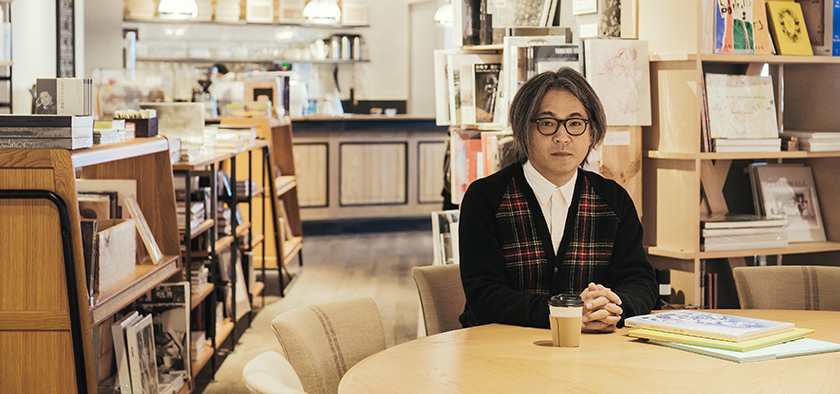
An event to sit around a fire and talk
Another thing I would like to do in Roppongi is to have a camp; it would be an event for setting up tents in the middle of the city and talking until morning. There would be one format, or rather one rule for this camp: we will sit around a fire to talk. I don't know why, but I've found from experience that when people talk around a fire, the conversation is positive and warm. If you were in a dark room talking to someone, the mood would be better if you had a candle instead of a LED spotlight, don't you think? I think flames are the symbol of civilization and fire has a great allure for humans.
If people from different kinds of fields - thinkers, architects, designers and artists - all gathered around a fire and talked, a new village would be created. Of course, we should have alcohol. If you get tired after doing a lot of talking you can just go to sleep. You might want to continue talking but you could be snoring before you know it. (laughs) It will be an event where people can have a primitive sort of experience. That kind of event is rare these days.
And in the morning when you wake up, baristas are stirring the charcoal fire to make coffee, and chefs are making scrambled eggs for everyone. It will be like a camp version of the "Diner en Blanc" in Paris. People can bring their own food or have a barbeque in special places that aren't usually open to the public. However, this event cannot be held in February when MAT is held - we would freeze to death! (laughs) Maybe it could be held in October during Tokyo Design Week.

Diner en Blanc
An event held in Paris each year where guests dressed all in white gather in a public place to enjoy a meal, setting up the tables themselves. The number of participants has increased each year and is estimated to exceed 10,000. Louvre Museum and the Arc de Triomphe were chosen as venues in the past. The venue changes each year and is kept a secret until the day of the event.
The creative act of holding a conversation
I suggested having a camp because I personally find that the most creative thing I can do is to meet people and talk. There are times when I'm talking to a friend and an acquaintance of the friend comes along. The friend introduces us to each other and the three of us get talking. The conversation might turn to a totally different topic and we usually end up saying to each other, "It's a small world, isn't it?" That's because we belong to a village. (laughs)
As I said earlier, the quality of "wa" (harmony) is the essence of Japanese culture. We mix elements to make new, refined things. People say that the Japanese are not sociable, but it's just that some Japanese are shy or the language barrier makes them diffident. Many Japanese who have high sensibilities have already gone abroad. From now on, more people from abroad will be coming to Japan. We're now in an age where we can have dialogue with people of different races, different cultures and different mindsets. The advances in education and technology will probably eventually bring down the language barriers. Perhaps that would be the genuine "kaikoku" (opening of the country).
In Roppongi, the shift of the times is already taking place and is a visible phenomenon. People from all over the world are gathered here and almost everyone is happy with it. It seems everyone is accepting of the current situation of co-existence.
Realizing the appeal of Japan
While Tokyo is a highly innovative city that keeps on evolving in areas such as art and technology, the culture and life of the countryside are unchanging. I think this contrast is one of appealing aspects of Japan. Places such as Kyoto, Nara, Shikoku and Setouchi are attractive; areas near Tokyo like Yokohama and Kamakura, and the Tohoku or Shinetsu regions and other areas are likely to become even more interesting in the future. We have a sophisticated information infrastructure and an intricate transport infrastructure that covers every part of this small country: we've managed to establish a level of safety and security that is the best in the world. If the Japanese themselves could become a little more aware of the appeal of Japan, visitors would surely be impressed not only with Tokyo but with Japan as a whole.
My hope is that Japan will become a country that earns more respect from other countries - not only for its materialistic aspects, but also for its spiritual aspects. I think the Japanese concept of harmony will be very useful in solving many global problems.
Japan is a country with the world's longest history. There are more than 50,000 Japanese companies with a tradition of 100 years or longer. There is no other country like that. Some of the visible things in Japan have been scrapped and rebuilt, but there are also a lot of things have been preserved for a long time. This is a fact that the Japanese should reflect on. If the people born this year live to the age of 85, they will be welcoming in the 22nd century. What kind of a future are we passing on to the new generation? That's a big question which we adults need to ask ourselves.
Editor's thoughts
Tanigawa-san laughingly told us that once he starts talking, it's difficult to stop. The interview went on longer than scheduled as Tanigawa-san spoke engagingly about a wide variety of topics. It is a pity that space restrictions prevent us from including all his comments. Next year, we are considering holding new projected related to Roppongi Future Talks to coincide with MEDIA AMBITION TOKYO. We hope these projects will interest our readers.(edit_kentaro inoue)




